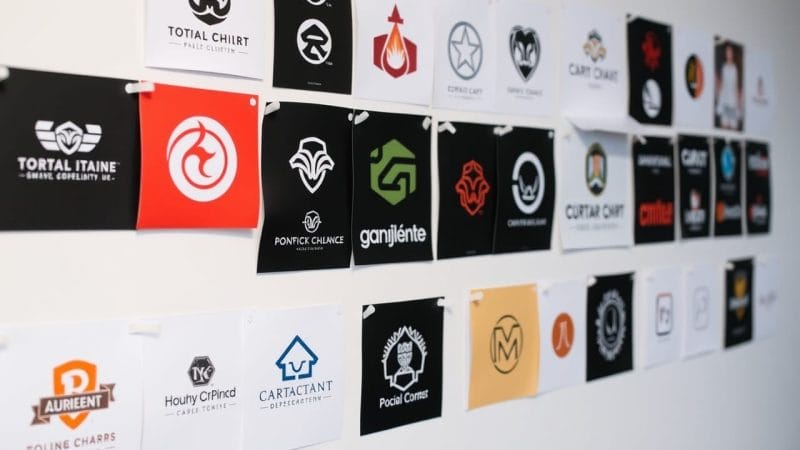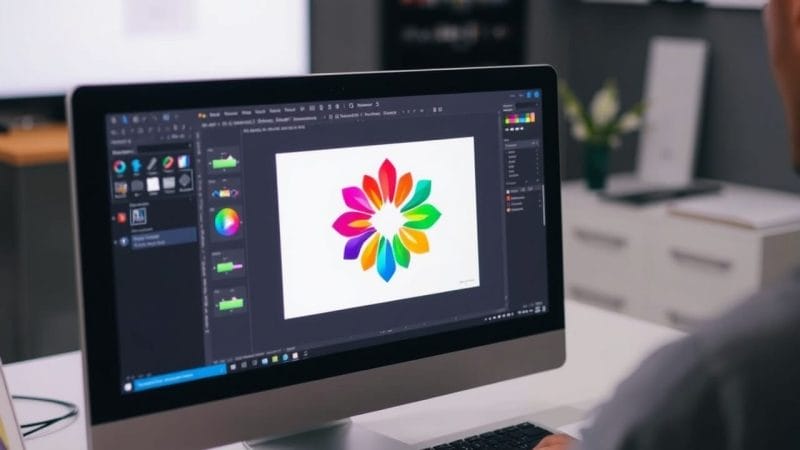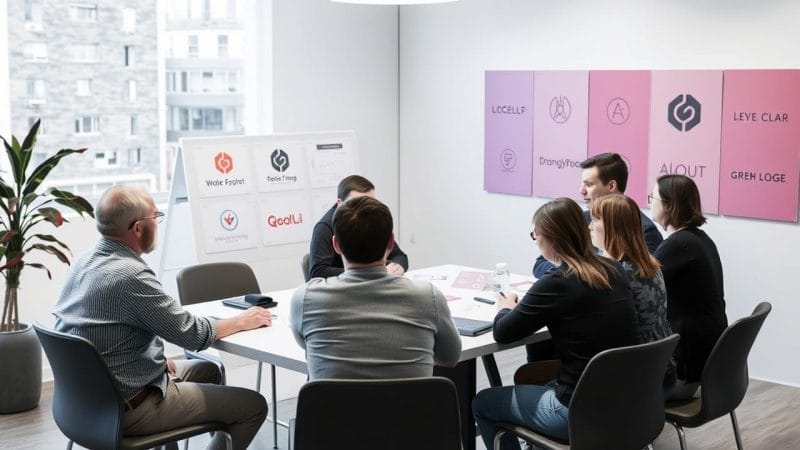Looking for expert custom logo design services? Professional logo design combines strategic brand thinking, current design trends, and technical expertise to create logos that drive recognition and business growth. Modern logo design in 2025 leverages AI-assisted workflows, adaptive design systems, and comprehensive brand identity frameworks.
Your logo is your brand’s most powerful asset—the visual anchor that communicates your values, builds recognition, and drives customer connection in milliseconds. Whether you’re launching a startup, rebranding an established business, or expanding into new markets, professional logo design services provide the strategic foundation for sustainable brand growth.
The Strategic Foundation of Professional Logo Design

Professional logo design transcends aesthetic choices—it’s a strategic business investment that impacts every customer touchpoint. Effective logos combine psychological triggers, cultural relevance, and technical precision to create memorable brand experiences that drive measurable business results.
Research shows that consistent brand presentation increases revenue by up to 23%. Your logo serves as the cornerstone of this consistency, appearing across digital platforms, marketing materials, product packaging, and customer communications. When designed strategically, logos become powerful business assets that appreciate in value alongside your company’s growth.
The Psychology Behind Effective Logo Design
Color psychology, typography selection, and symbolic meaning work together to create subconscious brand associations. Blue conveys trust and reliability, making it popular among financial and technology companies. Red triggers urgency and excitement, driving action in retail and food service brands. Green suggests growth and sustainability, resonating with eco-conscious consumers.
Typography choices communicate personality and positioning. Serif fonts suggest tradition and authority, while sans-serif typefaces project modernity and accessibility. Script fonts convey elegance and personalization, though they require careful application to maintain readability across digital platforms.
2025 Logo Design Trends That Drive Results

Current logo design trends reflect technological advancement, cultural shifts, and evolving consumer expectations. Understanding these trends helps position your brand as forward-thinking while avoiding designs that quickly become outdated.
Artistic Typography and Experimental Letterforms
Artistic typography dominates 2025 design trends, with brands using experimental serifs, exaggerated strokes, and custom letterforms to create distinctive visual personalities. This approach allows companies to communicate brand character directly through type treatment, reducing dependency on separate iconic elements.
Successful artistic typography balances creativity with functionality, ensuring readability across all applications while maintaining unique character. Consider how custom letterforms will render at small sizes, in single-color applications, and across various media formats.
Adaptive and Responsive Logo Systems
Modern brands require logo systems that adapt seamlessly across digital and physical touchpoints. Responsive logos include multiple variations optimized for different contexts: detailed horizontal versions for headers, simplified marks for social media profiles, and vertical lockups for mobile applications.
Adaptive design extends beyond size variations to include contextual modifications. Dark mode versions ensure visibility on various backgrounds, while high-contrast alternatives maintain accessibility compliance. Animation-ready components enable dynamic brand expressions across digital platforms.
Sustainable Design and Cultural Inclusivity
Environmental consciousness influences logo design through nature-inspired patterns, organic shapes, and earth-tone color palettes. These elements signal brand commitment to sustainability, resonating with increasingly eco-aware consumers who make purchasing decisions based on environmental impact.
Cultural fusion incorporates diverse design elements that reflect global perspectives and inclusive values. This approach creates visual richness while demonstrating cultural awareness—particularly valuable for brands serving diverse markets or international audiences.
The Professional Logo Design Process
Strategic logo development follows a systematic process that ensures alignment between business objectives and design outcomes. This methodology produces logos that not only look exceptional but also function effectively across all brand applications.
Discovery and Brand Strategy Development
Comprehensive brand discovery examines your business objectives, target audience characteristics, competitive landscape, and market positioning. This research phase identifies unique brand attributes that inform design direction and ensure competitive differentiation.
Stakeholder interviews reveal internal perspectives on brand personality, values, and aspirational goals. Customer research uncovers audience preferences, behaviors, and emotional triggers that influence purchasing decisions. Competitive analysis identifies visual territory to avoid while revealing opportunities for distinctive positioning.
Concept Development and Creative Exploration
Initial concept development explores multiple creative directions through rapid ideation and sketching. This divergent thinking phase generates diverse options before converging on the most promising directions for detailed development.
Concept refinement involves digital execution, color exploration, and typography pairing. Each direction receives thorough development to enable informed decision-making between distinctly different approaches rather than minor variations of similar concepts.
Technical Execution and File Preparation
Professional logo delivery includes comprehensive file packages optimized for all applications. Vector formats (AI, EPS, SVG) ensure infinite scalability without quality loss. Raster formats (PNG, JPG, TIFF) provide immediate usability across digital and print applications at various resolutions.
Color specifications include Pantone matches for offset printing, CMYK values for digital printing, RGB codes for screen display, and HEX values for web development. This comprehensive color system ensures consistent reproduction across all media.
AI-Enhanced Logo Design: Modern Tools and Workflows

Artificial intelligence transforms logo design workflows through automated ideation, rapid iteration, and intelligent refinement. While AI tools accelerate certain processes, strategic thinking and creative judgment remain essential for developing truly distinctive brand identities.
Professional AI-Assisted Design Tools
Leading AI logo generators like Looka, LogoAI, and Canva’s Magic Design produce sophisticated starting points for professional development. These platforms analyze industry conventions, color psychology, and typography trends to generate relevant concepts based on business descriptions and style preferences.
However, AI-generated concepts require human refinement to achieve strategic alignment and competitive distinction. Professional designers use AI tools for rapid exploration while applying strategic thinking, cultural awareness, and technical expertise to develop final solutions.
When to Choose AI Tools vs. Custom Design Services
AI logo generators work well for simple applications with limited budgets and standard industry requirements. They provide acceptable solutions for basic business needs without complex brand strategy requirements.
Custom design services become essential when you need strategic brand positioning, unique market differentiation, or comprehensive brand system development. Professional services provide trademark research, competitive analysis, and strategic consultation alongside creative execution.
Comprehensive Brand Identity Systems
Modern logo design extends beyond individual marks to encompass complete brand identity systems. These comprehensive frameworks ensure consistent brand expression across all touchpoints while providing flexibility for various applications and growth.
Logo Variations and Applications
Complete logo systems include primary marks, secondary versions, icon treatments, and typography lockups. Each variation serves specific applications while maintaining visual consistency and brand recognition.
Application guidelines specify proper usage, minimum sizes, clear space requirements, and color variations. These standards prevent dilution of brand impact through inconsistent implementation while providing practical guidance for various use cases.
Color Systems and Typography Pairings
Strategic color palettes extend beyond primary logo colors to include supporting hues for various applications. Primary colors establish brand recognition, while secondary colors provide flexibility for different contexts and materials.
Typography systems specify fonts for headlines, body text, and supporting applications. These selections complement logo design while ensuring readability, licensing compatibility, and consistent brand voice across all communications.
Legal Considerations and Trademark Protection
Professional logo design includes comprehensive trademark research to ensure legal protection and avoid infringement issues. This due diligence prevents costly legal complications while establishing your exclusive rights to the design.
Trademark searches examine existing registrations, pending applications, and common-law uses within your industry and geographic markets. This research identifies potential conflicts before significant investment in brand development and market introduction.
Trademark registration provides legal protection for your brand investment while establishing exclusive usage rights. This protection becomes increasingly valuable as your business grows and your brand recognition increases in the marketplace.
Industry-Specific Logo Design Strategies

Different industries require distinct design approaches that respect category conventions while achieving competitive differentiation. Understanding industry norms helps create logos that communicate appropriately to target audiences.
Technology and Innovation Sectors
Technology companies often favor clean, geometric designs that suggest precision, innovation, and reliability. Sans-serif typography, blue color palettes, and abstract symbolic elements create associations with cutting-edge solutions and technical expertise.
However, technology branding increasingly emphasizes human connection and accessibility. Warmer colors, friendly typography, and approachable visual styles help technical companies appear more relatable to broader audiences.
Healthcare and Professional Services
Healthcare brands prioritize trust, competence, and compassion through conservative color choices, readable typography, and symbolic elements that suggest care and expertise. Blue and green dominate healthcare branding, while serif fonts add authority and tradition.
Professional services require similar trust-building elements with additional emphasis on sophistication and expertise. Subtle color palettes, refined typography, and classical proportions communicate competence and reliability.
Retail and Consumer Brands
Consumer-facing brands embrace emotional connection through vibrant colors, playful typography, and distinctive visual personalities. These brands often push creative boundaries to capture attention in crowded marketplaces.
Retail logos must work effectively at various scales, from large storefront signs to small product labels. Versatility becomes crucial for brands with extensive product lines and diverse marketing applications.
Implementation and Brand Launch Strategy

Successful logo launches require strategic planning and phased implementation across all brand touchpoints. This systematic approach ensures consistent brand presentation while maximizing impact and recognition.
Digital Platform Integration
Digital implementation begins with website headers, social media profiles, and email signatures—high-visibility touchpoints that establish immediate brand recognition. Consistent application across digital platforms reinforces brand identity while improving professional credibility.
Social media requires specific adaptations for various platform requirements. Square profile images, horizontal cover photos, and favicon versions ensure optimal presentation across different digital contexts.
Marketing Material Integration
Print and digital marketing materials showcase logo versatility while building brand recognition through consistent application. Business cards, brochures, advertisements, and promotional materials create multiple touchpoints for brand exposure.
Consistent color reproduction across different printing methods and digital displays requires careful file preparation and vendor communication. Brand guidelines help ensure accurate implementation regardless of production method.
Measuring Logo Design Success and ROI
Professional logo design investment produces measurable business results through improved brand recognition, customer trust, and competitive differentiation. Tracking these metrics demonstrates design value and informs future brand development decisions.
Brand recognition studies measure unprompted and prompted logo recall among target audiences. Increased recognition typically correlates with improved business performance and customer acquisition. Customer perception surveys reveal brand associations and emotional responses to logo design.
Business metrics including website traffic, social media engagement, and lead generation often improve following professional logo design implementation. These indicators demonstrate the practical value of strategic visual identity development.
Partner with Scope Design for Professional Logo Development
Scope Design combines strategic thinking, creative excellence, and technical expertise to develop logos that drive measurable business results. Our comprehensive approach includes brand strategy, competitive analysis, and complete identity system development.
Our process begins with thorough business analysis and stakeholder consultation to understand your unique positioning and objectives. We then develop multiple creative directions that align with your strategic goals while ensuring competitive differentiation and market appeal.
Every Scope Design logo project includes comprehensive file packages, brand guidelines, and implementation support to ensure successful launch and consistent application. We also provide trademark research consultation and ongoing brand development services as your business grows.
Ready to develop a logo that drives recognition, builds trust, and supports sustainable business growth? Contact Scope Design today to discuss your brand identity objectives and explore how professional logo development can accelerate your marketing effectiveness and competitive positioning.



